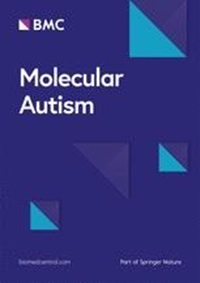Contracted functional connectivity profiles in autism
IF 6.3
1区 医学
Q1 GENETICS & HEREDITY
引用次数: 0
Abstract
Autism spectrum disorder (ASD) is a neurodevelopmental condition that is associated with atypical brain network organization, with prior work suggesting differential connectivity alterations with respect to functional connection length. Here, we tested whether functional connectopathy in ASD specifically relates to disruptions in long- relative to short-range functional connections. Our approach combined functional connectomics with geodesic distance mapping, and we studied associations to macroscale networks, microarchitectural patterns, as well as socio-demographic and clinical phenotypes. We studied 211 males from three sites of the ABIDE-I dataset comprising 103 participants with an ASD diagnosis (mean ± SD age = 20.8 ± 8.1 years) and 108 neurotypical controls (NT, 19.2 ± 7.2 years). For each participant, we computed cortex-wide connectivity distance (CD) measures by combining geodesic distance mapping with resting-state functional connectivity profiling. We compared CD between ASD and NT participants using surface-based linear models, and studied associations with age, symptom severity, and intelligence scores. We contextualized CD alterations relative to canonical networks and explored spatial associations with functional and microstructural cortical gradients as well as cytoarchitectonic cortical types. Compared to NT, ASD participants presented with widespread reductions in CD, generally indicating shorter average connection length and thus suggesting reduced long-range connectivity but increased short-range connections. Peak reductions were localized in transmodal systems (i.e., heteromodal and paralimbic regions in the prefrontal, temporal, and parietal and temporo-parieto-occipital cortex), and effect sizes correlated with the sensory-transmodal gradient of brain function. ASD-related CD reductions appeared consistent across inter-individual differences in age and symptom severity, and we observed a positive correlation of CD to IQ scores. Despite rigorous harmonization across the three different acquisition sites, heterogeneity in autism poses a potential limitation to the generalizability of our results. Additionally, we focussed male participants, warranting future studies in more balanced cohorts. Our study showed reductions in CD as a relatively stable imaging phenotype of ASD that preferentially impacted paralimbic and heteromodal association systems. CD reductions in ASD corroborate previous reports of ASD-related imbalance between short-range overconnectivity and long-range underconnectivity.自闭症患者的收缩功能连接特征
自闭症谱系障碍(ASD)是一种与非典型大脑网络组织相关的神经发育疾病,先前的研究表明,功能连接的长度会导致不同的连接改变。在此,我们测试了 ASD 的功能连接病变是否与长程功能连接的中断有关。我们的方法将功能连接组学与测地距离绘图相结合,研究了宏观网络、微观结构模式以及社会人口学和临床表型之间的关联。我们研究了来自 ABIDE-I 数据集三个站点的 211 名男性,其中包括 103 名确诊为 ASD 的参与者(平均 ± SD 年龄 = 20.8 ± 8.1 岁)和 108 名神经典型对照者(NT,19.2 ± 7.2 岁)。对于每位参与者,我们通过结合大地测量距离映射和静息态功能连通性分析,计算了皮层范围内的连通性距离(CD)测量值。我们使用基于表面的线性模型比较了ASD和NT参与者的连接距离,并研究了连接距离与年龄、症状严重程度和智力评分的关系。我们将CD改变与典型网络联系起来,并探讨了与功能和微结构皮质梯度以及细胞结构皮质类型的空间关联。与NT相比,ASD患者的CD普遍减少,一般表明平均连接长度缩短,从而表明长程连接减少,但短程连接增加。减少的峰值集中在跨模态系统(即前额叶、颞叶、顶叶和颞顶枕叶皮层的异模态和旁模态区域),效应大小与大脑功能的感觉-跨模态梯度相关。与 ASD 相关的 CD 减少似乎与年龄和症状严重程度的个体间差异一致,而且我们观察到 CD 与智商分数呈正相关。尽管在三个不同的采集地点进行了严格的协调,但自闭症的异质性可能会限制我们结果的推广性。此外,我们的研究对象以男性为主,因此未来的研究需要更均衡的群体。我们的研究表明,CD 的减少是 ASD 的一种相对稳定的成像表型,它优先影响边缘系统和异模式联想系统。ASD 中 CD 的减少证实了之前关于 ASD 相关的短程过度连接和长程连接不足之间不平衡的报道。
本文章由计算机程序翻译,如有差异,请以英文原文为准。
求助全文
约1分钟内获得全文
求助全文
来源期刊

Molecular Autism
GENETICS & HEREDITY-NEUROSCIENCES
CiteScore
12.10
自引率
1.60%
发文量
44
审稿时长
17 weeks
期刊介绍:
Molecular Autism is a peer-reviewed, open access journal that publishes high-quality basic, translational and clinical research that has relevance to the etiology, pathobiology, or treatment of autism and related neurodevelopmental conditions. Research that includes integration across levels is encouraged. Molecular Autism publishes empirical studies, reviews, and brief communications.
 求助内容:
求助内容: 应助结果提醒方式:
应助结果提醒方式:


